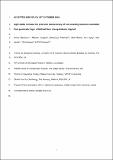Light stalks increase the precision and accuracy of non-breeding locations calculated from geolocator tags : a field test from a long-distance migrant
Abstract
Capsule: There is a substantial gain in precision and accuracy of geolocator locations when using a light stalk. Aims: Light stalks or tubes increase the accuracy of geolocators when tracking migrant birds because they reduce potential shading of the light sensor by feathers but may increase detrimental tag effects. We aimed to determine how adding light stalks to geolocator tags increased accuracy and precision of locations. Methods: We quantified how precision and accuracy of geolocator locations was affected by comparing variation of sunrise and sunset times from tags with variable length light stalks (6 of 0 mm, 8 of 5 mm and 21 of 10 mm). Tags were fitted to Whinchats Saxicola rubetra in central Nigeria (the known location to compare accuracy), and variance in latitude and longitude of geolocator estimated locations were also compared across light stalk lengths during spring migration stationary locations, and at breeding sites in Eastern Europe, for both Geolight and FlightR methods. Results: Without a light stalk, the standard deviation of sunset and sunrise times increased by 50% and 100% respectively (i.e. less precise): confidence intervals for latitude were larger by about 4.3 degrees at non-breeding low latitudes and 1.8 degrees at stop-over latitudes, or confidence intervals for longitude were larger by 2.3 degrees, dependent on analysis method. Estimated sun elevation angles were significantly less accurate and so calculated non-breeding locations were significantly less accurate by about 8 degrees of latitude. Precision in sunrise, sunset times, latitude and longitude, was similar when using a 5mm or 10mm stalk. Conclusions: The results show a substantial gain in precision and accuracy of low latitude geolocator locations when using a light stalk that brings the sensor above covering feathers. There is no advantage from longer light stalk lengths than those necessary to just expose the light sensor above the feathers, at least for small passerines.
Citation
Blackburn , E , Burgess , M , Freeman , B , Riseley , A , Azang , A , Ivande , S T , Hewson , C & Cresswell , W 2019 , ' Light stalks increase the precision and accuracy of non-breeding locations calculated from geolocator tags : a field test from a long-distance migrant ' , Bird Study , vol. 66 , no. 3 , pp. 353-365 . https://doi.org/10.1080/00063657.2019.1690421
Publication
Bird Study
Status
Peer reviewed
ISSN
0006-3657Type
Journal article
Description
This work was supported by the Chris Goodwin, A.P. Leventis Conservation Foundation, AP Leventis Ornithological Research Institute, the British Ornithologists’ Union and the Linnean Society.Collections
Items in the St Andrews Research Repository are protected by copyright, with all rights reserved, unless otherwise indicated.

